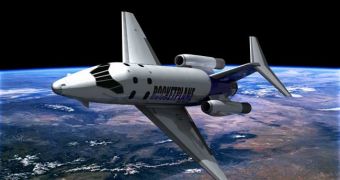Have you ever wondered why airplanes can't be used for spaceflight? Escaping the Earth's gravity is somehow tricky even with the current technology and keeps most of us stranded on the surface. Even NASA has sometimes problems getting its shuttle into space.
The first attempt to put a man into space was not made with the help of an airplane, but with a rocket. This is mainly because of the Earth's gravity. Any object that is designed to escape the gravity has to have the capability of exceeding speeds of 11 kilometers per second. The disadvantage of the sub-sonic commercial airplanes is that they can't fly near that fast, as their engines cannot produce the necessary thrust to propel them at those speeds.
The shortest distance between Earth and space is about 100 kilometers straight up. To get the shuttles into space, NASA uses a combination of two solid fuel rocket boosters with a about 140,500 liters of fuel, plus an external liquid fuel tank, to liftoff a space shuttle that may exceed a weight of 100 tons and propel it into space in under nine minutes. Executing a liftoff that involves horizontal flight to get in Earth's orbit would require a volume of fuel so large that the spacecraft would not even be able to carry it.
The airplanes could theoretically be able to fly into orbit, if they were specially designed to do that. All the conventional aircrafts produced today which are used for commercial flight use the airfoil effect to keep themselves in the air, which require relatively low speeds. However, the airfoil effect has no use in space. The fact that the space shuttle has wings has nothing to do with flying in space, but rather they are used on the re-entry in the Earth's atmosphere to fly in the same way as the airplanes, so the space shuttles would be re-usable.
Nevertheless, most of the spacecrafts used to reach space in the X-Prize competition are aircraft-based vehicle designs. Such spacecrafts are designed by Burt Rutan and his firm Scaled Composites, in the attempt to build a suborbital rocket ship, named SpaceShipOne, which are launched from a high altitude with the help of aircrafts and ignite rocket engines to reach suborbital space, before turning back to the surface of Earth.
X-Prize foundation represents a non-profit institute that designs and manages public competition to test vehicles that might have the capability of spaceflight, in the benefit of humankind.
Similar planes have been also developed by the U.S. Army to reach the edge of space with the X-15 rocket planes, designed by Oklahoma's Rocketplane Global Inc., in the hope that they will produce a private air jet with rocket engine, to be used for future spaceflight and suborbital space tourism.

 14 DAY TRIAL //
14 DAY TRIAL //